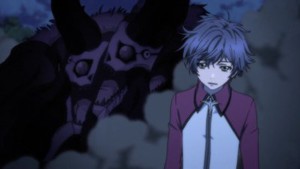Winter 2013: Carlo Santos
He may not be a giant robot pilot or nationally renowned alchemist, but Carlo is really, really good at having opinions about anime and manga. He is best known for reviewing manga in his biweekly column, Right Turn Only!! Carlo's favorite anime series of the last few seasons include Another, Black Rock Shooter, Kids on the Slope, Polar Bear Cafe, Joshiraku, From the New World, Psycho-Pass, and he is terribly excited for the continuation of Chihayafuru.

Hakkenden: Eight Dogs of the East
Rating: 2 (of 5)
Review:
Episode 1 of Hakkenden: Eight Dogs of the East suffers from a problem that plagues many fantasy-action series: too much to tell in too little time. The early scenes are especially bad at this, jumping around wildly in an effort to introduce everyone and everything. The series' main characters are three close-knit youths who survived a fire that destroyed their village: impetuous boy hero Shino, demure beauty Hamaji, and big-brother figure Sosuke. Predictably enough, Shino has some latent magical ability, but hides it pretty well for a while ... because the episode forces several minutes of boring village life down everyone's throats first. However, we do learn from Sosuke that the local forest harbors some dark secrets—so Shino and his villager buddy Kenta ought to stay away from there. (Who wants to bet they still wander into the forest anyway? Yes, good guess!)
The series' pivotal moment comes when mysterious masked men come looking for Shino and Kenta because of their troubled past. Despite this intrigue, the show remains vague about what's going on, because how else are people going to be motivated to watch the next episode? Only after Kenta is attacked in the dark forest, and Hamaji gets kidnapped, do Shino and Sosuke finally resolve to take action. It all boils down to a theological war between the Church and the traditional gods of Japan, which actually sounds incredibly cool—yet is revealed in a painfully roundabout way.
Not only is the series bogged down by sloppy storytelling, but the animation coasts along for much of the episode. Dialogue scenes, which make up much of the first half, are often nearly static—just put those pretty character designs in there, then flap their mouths and bob their heads a few times. The action scenes when Shino breaks out his magic are more effective—but mostly because computer-generated effects provide a handy crutch. A generic compose-by-numbers soundtrack (is that the Pokémon battle music?) doesn't inspire much confidence either. Hakkenden is trying to get by on being a perfectly average fantasy action series, and I don't have time for average.
Hakkenden: Eight Dogs of the East is available streaming on Crunchyroll.

Tamako Market
Rating: 3.5 (of 5)
Review:
Shiny eyes, pigtails, and a spring in her step—the main character of Tamako Market is this season's contribution to "the K-ON! look," taking it out of the schoolyard and bringing it to the mom-and-pop shop. Tamako is the teenage daughter of a family that sells mochi—round, floury rice cakes—and her story begins as she's strolling through the local shopping arcade that she calls home. While visiting the florist, Tamako comes face to face with a strange, chicken-sized bird ... which suddenly starts talking to her.
At that moment, the bird steals the show for the rest of the episode. His inexplicable behavior brings a spark of offbeat humor to every scene: the bird insists on being called Dera Mocchi'mazzui (a nonsense pun on "Mochi tastes nasty"), he delusionally believes that Tamako is attracted to him, he invades the public baths ... and has a life-threatening accident that leads him into staying with the family a little longer than expected.
Along the way, we're also introduced to the ordinary people in Tamako's life, including her family members (did they really name the younger sister after bean paste?), the rival mochi shop next door (including a teenage boy that screams romantic interest the moment he shows up), and some local customers. There's just one problem: where is the show going with all this? Crazy bird antics and idyllic scenes of working-class life are one thing, but there are no plot points pushing the show forward: right now the main impetus to watch Episode 2 is "because Episode 1 seemed cute and funny."
High production values are another reason for sticking around despite the plotlessness. Between the fluid character movement, lively slapstick moves (especially the bird), and richly detailed backgrounds, this is an exemplary piece of animation so far. It also benefits from cheery but not too obnoxious music that sets the right mood. Tamako Market puts on a very polished, appealing façade—but it'd be nice if there were more to it on the inside.
Tamako Market is available streaming at The Anime Network.

Love Live! School Idol Project
Rating: 2.5 (of 5)
Review:
Love Live! School Idol Project tackles the issue of Japan's population crisis, where a declining youth demographic is forcing schools to close down. Actually, no, it's just about several girls who want to form a pop idol group in a last-ditch attempt to save their school. Because hey, who needs logic and economics when you've got the power of dreams?
The series centers on second-year student Honoka, who is mortified to hear that her campus will no longer be accepting incoming students as of next year. Early on, the episode tries to express the nostalgia of academic life—Honoka's mother and grandmother both attended the same school, yet now the glamour of a modern mega-institution with their very own affiliated idol group is luring students away.
Once the premise is set, the episode settles into a boring, by-the-numbers groove where Honoka and friends—despite self-doubts and resistance from the student council—swear that they're going to become top-rate idols and save the school from going under. This even comes with a performance number that blindly follows all the rules of how idol songs should sound (catchy and chirpy) and how animated idol dances should look (simple, repeatable and computer-assisted).
It's hard to see Love Live! as anything but the awkward distant cousin of shows like Idolm@ster and AKB0048—it jumps aboard the current idol wave, but lacks name recognition or even a bombastic space-opera plot to back it up. The all-female cast suffers from a lack of creative character designs (suspicious Im@s fans might even note some striking resemblances), and the suburban slice-of-life setting provides little visual interest, no matter how bright and polished it looks. Ultimately, this genre is all about glitzy stage performances, and Episode 1 fails to differentiate itself from similar series in that regard. They say that idols always try their best—but this show, from a story and animation perspective, tries barely hard enough.
Love Live! School Idol Project is available streaming on Crunchyroll.

Senran Kagura
Rating: 1 (of 5)
Review:
What do people love about anime? Ninjas! What else do they love? Schoolgirls! So nothing could be better than an anime about ninja schoolgirls, right? Sadly, Senran Kagura proves the opposite to be true: nothing could be worse than an anime about ninja schoolgirls, especially when it shows more interest in the bounciness of their chests than the craftiness of their jutsu.
Episode 1 introduces Asuka, a young shinobi-in-training who uses her ninja skills—and ability to strip out of her clothes quickly—to outwit opponents. But Asuka's abilities still need more refinement, which is why she's starting a new term at her secret ninja school. We eventually meet Asuka's classmates, who are all just as well-endowed as she is, as well as the trainer who sends them out on a field mission for the rest of the episode. The series' attempts at action are a laughable hodgepodge of hack-and-slash elements: the girls have to fight a gang of delinquents in an alleyway, but beyond that lies a sinister twist, and it's all being engineered by a handful of scheming villains. Plus, just to make sure no one misses out on any fanservice, the girls go through a revealing transformation sequence as they switch from school uniforms to battle gear.
The story is so weak that they still need a narrator to push it along, and he just makes obvious comments like "These are who the ninjas are, and this is what they do, and watch out for these bad guys." Not even the "But the girls are cute!" excuse can save this one—they're just different faces and hairstyles swapped onto the same body type, with the barest of personality traits assigned to each one.
Cheap animation is everywhere in this episode as well, from the flat, static backgrounds to the action scenes that cut corners and go to slideshow mode whenever they can. But hey, they make sure to animate every possible boob jiggle—now that's effort! Actually, no, that's just embarrassing, and further proof that ninjas and schoolgirls were never meant to meet in this way.

THE UNLIMITED Hyobu Kyosuke
Rating: 4 (of 5)
Review:
Remember when Zettai Karen Children came out a few years ago and regaled viewers with exciting psychic adventures? Of course not; it barely made a dent and nobody ever cosplays that series. However, it did give us the ruthless silver-haired villain Hyobu Kyosuke, whose spinoff series stands well enough on its own that prior knowledge isn't necessary.
Turning an antagonist into a protagonist is no easy task, but this pilot episode figures out a way to do it: surround the bad guy with even worse guys. Kyosuke's adventures begin when he is captured by anti-ESPer forces and sent to a prison camp specifically designed to block ESP abilities. With a heartless prison warden running the place, and guards who treat the inmates worse than livestock, it's easy to sympathize with Kyosuke's plight—even if he is a homicidal maniac just waiting to bust loose on everyone.
Despite a slow first half, the episode more than makes up for it with an action-packed prison break in the latter part. Kyosuke teams up with seemingly powerless inmate Andy Hinomiya, and together they take on everything the prison has to offer: gun-toting guards, maze-like hallways, the warden once again, and even a top-ranked "Level 7" psychic beast. That's where Kyosuke brings out his heavy artillery, and the series' animation staff prove themselves with a barrage of special effects, high-speed moves, and dynamic camerawork. All that's left, then, is for Kyosuke to reunite with his psychic cabal P.A.N.D.R.A., bringing Andy and a well-dressed little girl (Never trust the cute ones!) in tow.
Aside from the action highlights, the series' overall crisp visual design and smooth animation look promising. In addition, the intense look of the main characters and a dramatic, urgent soundtrack round out the key components of a high-octane action series. The fancy poses and sneering taunts from Kyosuke are a bit on the clichéd side, but his antiheroic attitude is nothing if not compelling. This show is probably going to turn out pretty good ... in an evil way.
THE UNLIMITED Hyobu Kyosuke is available streaming on Crunchyroll.

Minami-ke Tadaima
Rating: 3 (of 5)
Review:
Of all the cute-girls-doing-cute-things franchises that had gone into hibernation, how many people were wagering on Minami-ke making a comeback? Anyone who did, come and collect your bets, because this season Minami-ke Tadaima revives the oddball humor of its predecessors.
Like before, the show centers on the three sisters of the Minami family: level-headed caretaker Haruka, boisterous middle child Kana, and quiet, calculating Chiaki. Kana leads the way in Episode 1 with her harebrained schemes to get ahead in life. First she tries to improve her grades with the help of class brain Keiko, but her roundabout way of asking soon backfires on her. Then, Kana tries to swipe a donut from Chiaki's friend—which quickly turns into a bizarre battle of retaliation. The funniest reactions come out of the situation where Kana gets a New Year's fortune, takes the message too seriously, and starts freaking out whenever someone interacts with her. Finally, Haruka gets some action in the last segment when Kana tries to pack up the kotatsu (heated table) despite Haruka's insistence that it's still cold enough to have it out.
As always, this sounds pretty mundane on paper, but Minami-ke is all about execution—and it executes well when Kana is making pompous pronouncements or trying to outwit her sisters and classmates in the weirdest ways possible. The deadpan delivery also helps—the show doesn't desperately try to mug for laughs, but instead lets punchlines land where they may, allowing the silliness to speak for itself. However, this also means that the first episode goes through a few dull stretches where the characters ramble on and on without purpose.
Animation is a weak point for the series, as the school-and-home setting provides few opportunities for dramatic visuals. All they do is sit and chat, and when the characters do move about, it's usually done with the fewest frames possible—no epic pratfalls or super-slo-mo moments like in the first season. Ultimately, viewers will have to buy into Minami-ke Tadaima's sly sense of humor to enjoy it, because it offers little else in other areas.

Oreshura
Rating: 2 (of 5)
Review:
Oreshura is the worst kind of school-life show. Nothing really happens for most of Episode 1, and when something finally does, it's stupidly trivial. Most people have no patience for romantic gossip in real life, so why make such a big deal of it when it happens in animation?
Oreshura's protagonist is Eita Kidou, a studious young man who just wants to get into a top medical school without distractions. This point is emphasized to the point of boredom in the episode's first act, where Eita performs bland activities like attending class and making dinner. At the halfway point, Eita just happens to get a seat next to the school's most talked-about beauty, Masuzu Natsukawa—and of course several more minutes are spent on the entire class chirping about whether Eita is going to take an interest in her. Eventually, the ice cracks and Natsukawa asks Eita to walk her home from school (collective gasp and shock from everyone!) ... but her motives are not so simple. In a long, talky final act, it turns out Natsukawa is just as calculating as Eita, and has no patience for "who's in love with who." She only wants to pair up with him to make the rest of the school shut up, and has some blackmail leverage in case he refuses her demands.
The idea of a disinterested romantic couple trying to fake their way through it could be interesting ... but Oreshura handles it poorly. The first episode simply shuffles its way from one cliché to another, with vapid classmates providing commentary on Eita's existence, punctuated by occasional cues of easy-listening music. If this is an attempt to bore people out of their minds, it's a raging success.
Decent visuals are the series' one saving grace so far: crisp linework, fluid character animation, and a light, pleasant color scheme make this easy on the eyes. It may not be terribly innovative in the character design and backgrounds department, but it gets the job done. Unfortunately, the storyline itself doesn't seem to be doing the job at all.
Oreshura is available streaming on Crunchyroll.

Cuticle Detective Inaba
Rating: 2 (of 5)
Review:
Cuticle Detective Inaba deserves a little credit for trying. Unfortunately, the problem is that it tries too hard, cramming in random punchlines every 15 seconds as compensation for second-rate animation and a story that's all over the place. Out of the madness comes the following premise: Hiroshi Inaba is an anthropomorphic "police dog" (and sometimes werewolf) who has a knack for hunting down suspects using just a sample of their hair. Because of this special ability as a "cuticle detective," Inaba is often called on by the police to help in high-stakes cases—which in this episode means tracking down a currency counterfeiter. The trail eventually leads them to Don Valentino, an Italian mob boss who also happens to be ... a goat. That's about when it morphs from a goofy police procedural to a totally mindless, throw-everything-at-the-wall exercise in comedy.
The latter half of the episode involves quick, slapstick escapades where Inaba and his crew tangle with Valentino in various ways. A couple of snappy jokes and well-timed punchlines make their way in—most notably a flashback to Don Valentino's childhood, where a classic fairytale cleverly provides the back-story for his grudge against Inaba. But in between those moments of lucidity comes a whole lot of chaos and nonsense, especially at the end, where Inaba and friends stroll into a trap and fight their way out by means of a near-incomprehensible action sequence.
Thanks to the hyper-speed pacing, the series keeps up a constant barrage of visual stimuli—pratfalls, reaction faces, and wild flights of the imagination. But having to animate that much content every week comes with a price: the character designs are pathetically simple (aside from when they want to show off Inaba in his bishonen werewolf mode), and the background scenery is barely adequate. In a series where gags take top priority, artistic quality takes the biggest hit. Overall, this show has flashes of creativity, but lacks the discipline to come out as anything but a big, noisy mess.
Cuticle Detective Inaba is available streaming on Crunchyroll.

Maoyu
Rating: 3 (of 5)
Review:
For the first five minutes, Maoyu plays itself off as a perfectly ordinary (and boring) fantasy series. It starts off with the basics: an epic war between humans and demons, a needlessly complicated back-story, various characters with special abilities, and a peppy pop-rock opening theme. Right away, the series' nameless protagonist charges into the Demon King's castle, hoping to capture a glorious victory ...
And then things start getting weird.
As soon as the Hero enters the Demon King's chambers, he finds that his foe is an attractive, well-endowed young woman. Even more surprisingly, she has no interest in battling him. Instead, she launches into a sly takedown of the politics and economics behind the entire fantasy genre. There is no real war with "the demons," she explains; it's a shell game invented by humans to keep society afloat. As long as humanity is endlessly at war, the economy can just barely creak along, while more prosperous nations feed off the spoils. And now that our young hero has been completely disarmed by what he's just heard, perhaps he would like to join her on a thrilling journey of exploration?
With that bizarre twist, and the thought-provoking discussion that follows, Maoyu overturns all the usual genre expectations. Oh, it still has all the production values one would expect of a high-end fantasy series—eye-catching landscapes and interiors, rich visual textures and nuanced colors, plus a sense of character design that follows all the good rules about how medieval people ought to dress. But the story itself sidesteps any clichés about a boy of destiny, an unstoppable magical weapon, or an important prophecy. For those who are tired of anime's staleness, this topsy-turvy approach is a breath of fresh air. But the lack of a conventional structure means that the dialogue-laden first episode can come off as dull, or even pretentious, to those who wanted a good old sword-swinging, magic-blasting adventure. Basically, Maoyu dares to take the genre in a new direction—but no one knows if it's going to be an easy, or even pleasant, ride.
Maoyu is available streaming on Crunchyroll.
Winter 2013 Shorts

Mangirl!
Rating: 2.5 (of 5)
Review: Okay, you can all stop snickering at the title of Mangirl!—the series has nothing to do with gender-bending. Rather, it's a fusion of the words "manga" and "girl," and—in predictable anime fashion—uses cute girls and brightly-colored visuals to explain how things work in the manga business. In three frenetically-paced minutes, the first episode gets as far as assembling an editorial team and trying to recruit artists for a new monthly manga magazine. Although the girls squeal and giggle their way through the process, they also share some informative tidbits: a rough cost-and-revenue calculation shows just how thin profit margins are in the business, and later they gripe about how hard it is to sign new artists when everyone is wary of startup magazines that fail shortly afterward. Sadly, the short format makes it hard for the series to expound on industry issues—but then again, anime itself operates on extremely thin proft margins. Why pay to produce a half-hour show when people will still show up to watch a three-minute one?
Mangirl! is available streaming on Crunchyroll.

Encouragement of Climb
Rating: 3 (of 5)
Review: Also entering the weird title sweepstakes this season is Encouragement of Climb, which takes on the rarely-addressed subject of mountain climbing. However, it does so from the viewpoint of a high school girl named Aoi, so viewers will have to sit through all the usual clichés where she wants to have a rosy-cheeked youth but is too shy to hang out with anyone. However, that all changes when childhood friend Hinata barges back into her life, and insists that Aoi go mountain climbing with her just like they did when they were kids. The only catch? Aoi had a severe accident during their years apart and is now afraid of heights. The story shows promise as an inspirational (if predictable) "Make the most of your youth" parable, but again, the bite-size format wil make it hard for the series to develop to its full potential. Quality visuals, including some beautifully detailed landscape shots, also prove that this series has some genuine effort going into the animation. If only it could hold that standard of quality for longer than three minutes a week.
Encouragement of Climb is available streaming on Crunchyroll.

Ai-Mai-Mi
Rating: 0.5 (of 5)
Review: Could Ai-Mai-Mi's timing be any worse? It comes out just a day after Mangirl!, is about the exact same topic, but is inferior in every possible way. The series charts the adventures of three high school girls named Ai, Mai, and Mi, who participate in the manga club but spend most of their time goofing off. The one good gag in Episode 1 involves poking fun at Ai's homegrown epic fantasy series; anyone who's had to explain their own creative endeavors to their friends will understand her embarrassment. However, everything else about the show is a failure: the absolute lack of plot (the previous two shows at least have a "What next?" angle), the incomprehensible puns, and the much-reviled tactic where, if the characters scream enough and act stupid enough, someone might find it funny. Even then, that someone would have to get past the sloppy character designs and animation that could have been drawn on the back of a cereal box. You know it's bad when they appear to have spent more time on the retro-gaming ending sequence.
Ai-Mai-Mi is available streaming on Crunchyroll.
discuss this in the forum (727 posts) |
this article has been modified since it was originally posted; see change history
back to The Winter 2013 Anime Preview Guide
Season Preview Guide homepage / archives